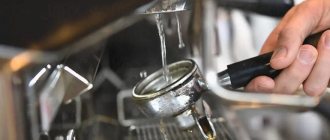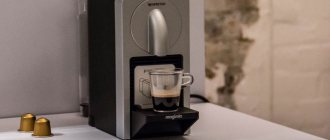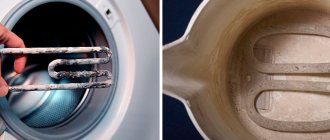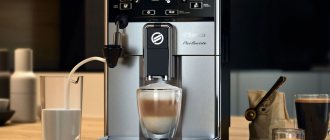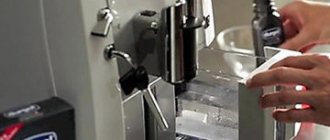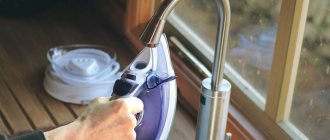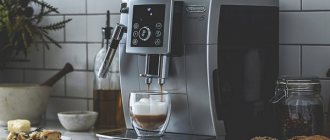How can I clean my coffee machine?
How to descale a coffee machine
- Prepare 0.5 - 1 l. ...
- Pour water and add cleaning agent into the coffee machine hopper.
- Start the automatic cleaning program.
- Or turn on the coffee program 3-4 times. ...
- Rinse the hopper and fill it with clean water.
29 Jan
2022 Interesting materials:
How to connect to a router? How to assign a category to an accountant? How to assign a page number in Word? How to clean up a rusty cast iron frying pan? How to clean the siphon under the sink? How to clear a heavy clog in the bathroom? How to unclog a bathroom sink drain? How to unclog a bathtub with baking soda? How to unclog a bathroom pipe? How to clean a bathtub with soda?
How does scale appear?
Any drinking water, even bottled or filtered, contains a certain amount of dissolved salts, mainly calcium, magnesium, and iron compounds.
When water is heated to a boil, some of the salts precipitate, which accumulates on the walls of the coffee machine, forming scale, which leads to wear of parts and breakdown of the device. Over time, this layer becomes thicker and denser. The rate of formation of the limescale layer depends on the concentration of salt in the water.
The harder the water, the more often you will have to clean the coffee machine to remove scale.
Cleaning with decalcifiers
All manufacturers of household appliances recommend using descaling products offered by the same company to descale your coffee machine. This is indicated in any instructions. However, all products are created using the same technology and have a similar composition. They are available in both liquid and tablet form:
- Not everyone can afford to clean a coffee machine using DeLonghi. Branded products are of high quality and guarantee excellent results.
- Cleaning a coffee machine with Saeco descaling agent is cheaper, but it is almost as good in terms of quality.
- Other companies offer their own cleaning products to care for household appliances.
DeLonghi
Saeco
Cleaning the cappuccino maker
If you have a built-in cappuccino maker, it must be removed and washed after each preparation of coffee with milk. Do not leave leftover milk for a long time - this can cause an unpleasant odor and even poisoning if rotten milk gets into the coffee. You can also use a special milk system cleaner.
Why are home methods not always effective?
A coffee machine that is used regularly cannot do without maintenance. Using vinegar or citric acid on the appliance is a temporary solution. Descaling your Saeco coffee machine with alternative tools is slower. Vinegar leaves a taste in the water. In addition, using one packet of acid at once does not guarantee that the inside of the machine is completely free of sediment.
A side effect is possible damage to the pipes due to regular use of acids. A more gentle product is Saeco coffee machine cleaning liquid. It has a chemical composition, but is easily washed out of the system without leaving an unpleasant odor or taste. The liquid product is universal and suitable for specific machine models, for example, Saeco Xsmall, Lirika or Minuto. The Philips coffee machine is equipped with instructions that describe in detail the process of servicing the device with products of the same brand. Regular cleaning of the Saeco Xsmall coffee machine can be carried out automatically using a range of products (liquids, tablets or powders) to remove scale and deposits.
Is it worth using traditional methods?
When deciding how to clean a coffee machine, you should remember the so-called traditional methods for descaling at home. In principle, you can save a little and clean your car from various salt and other deposits with such cheap and affordable products as vinegar or citric acid, since they are almost always available in the kitchen. In addition, branded liquids or tablets contain the same citric acid. But at the same time, unlike industrial products, it is easier to make a mistake in the proportions and not get the desired result, or even harm the machine. Therefore, if possible, it is better not to experiment with such products. Although it is useful to understand how to use them, so that in case of emergency (for example, if it is impossible to buy a special product), you can use them effectively without damaging the car.
Can I use citric acid?
Regular citric acid can be used for decalcification. This is a food product that, when reacting with lime deposits, leads to detachment and removal of lime deposits.
Cleaning procedure:
- Remove waste. Wash removable elements with water.
- Separately prepare a solution of 8 teaspoons of citric acid for each liter of water.
- Stir until the acid grains dissolve.
- Pour the resulting solution into the water tank.
- Leave to stand for several hours.
- After at least 2 hours, start the coffee brewing cycle. Whether or not to add coffee for this depends, as when cleaning with professional products, on the type of coffee machine.
- Drain the liquid.
- Rinse the tank.
Cleaning liquid with coffee should not be used in food.
The video will show you how to descale a coffee machine using citric acid:
How to descale a coffee machine with citric acid
Manufacturers offer a variety of descalers, but they are all quite expensive, and limescale must be removed every month. Large companies such as DeLonghi, Philips, Bosh produce branded cleaning products for their household appliances. You can find universal cleaners on sale, both liquid and tablets.
You cannot use descaling compounds designed to remove deposits from the surface of gas stoves or sinks; this will lead to damage to the machine. The main active ingredient in most branded products is citric acid. Many coffee machine owners have been cleaning their equipment themselves for years using a citric acid solution without causing harm to their equipment.
Citric acid has a number of undoubted advantages:
- safety for human health and the environment;
- efficiency, it removes even old scale;
- no toxic fumes when heated;
- accessibility, it is in any home;
- low price.
All this explains the popularity of citric acid as a cleaning agent for household appliances.
The main cleaning steps are the same as when using a store-bought product:
- filling the reservoir with cleaning solution;
- cleaning process;
- removal of cleaning solution;
- thorough washing.
Let's take a closer look at how to clean a coffee machine using home remedies; the instructions for servicing household appliances will help us with this.
Descaling
The main stages of descaling are the same for different types of coffee machines. It is necessary to strictly adhere to the instructions, only instead of using a special product, use citric acid, having previously diluted it in water.
If you haven’t cleaned your coffee machine for a long time and a solid layer of scale has formed, dissolve 50-100 g of citric acid in one liter of water. If you care for your household appliance regularly, a 30% solution is sufficient (proportions: 30 g of acid per 1 liter of water).
Sequencing:
- Prepare a solution, stir until the acid is completely dissolved.
- Fill the reservoir up to the mark indicating the maximum amount of liquid possible.
- Insert the container with the solution into the coffee machine and carry out the cleaning procedure, following the instructions. If your equipment does not have an automatic cleaning function, pour in the solution, wait a quarter of an hour, turn on the device by selecting the “coffee preparation” function.
- Turn off, remove the reservoir, pour out the remaining solution, rinse.
Almost all modern models have a scale formation indicator; if you do not have such a function, descale the coffee machine with citric acid every 1-2 months, depending on the frequency of use of the household appliance and the hardness of the water.
First rinse cycle
To prevent residual citric acid from spoiling the taste of coffee, the coffee machine must be rinsed thoroughly:
Fill the tank with clean water to the maximum level, install it in the machine, select the “coffee preparation” function without adding coffee powder. The first rinse will take you 3-5 minutes.
Second rinse cycle
To completely get rid of citric acid, rinse the tank thoroughly, fill it with clean water, and repeat the “coffee preparation” mode without adding coffee itself. This completes the procedure for cleaning the coffee machine with citric acid, and the scale has been removed.
Descaling Philips 1200/2200/3200 series models
Descaling procedure: 1 Drain the drip tray and replace it. 2. Remove the Classic Cappuccino Maker (if equipped) or LatteGo from the coffee machine. 3. If you have an AquaClean filter, remove it from the water tank. 4. Empty the water tank and pour a whole bottle of Philips descaler into it. Add water to the descaling solution tank up to the Calc/Clean mark and replace it. 5. Place a large container (1.5 l) under the coffee and water spout. 6. Turn on the coffee machine. 7. Press and hold the Calc/Clean icon for 3 seconds, then press the Start/Stop button to start the descaling procedure. 8. During the descaling cycle, the Calc/Clean indicator will flash to indicate that the descaling procedure is in progress. 9. The machine will begin dispensing a small amount of water through the coffee and hot water spout. 10. Let the machine run the descaling solution until the water tank is empty. The empty water tank indicator will light up. 11. Remove container. 12. Remove the water tank and rinse it with clean water. 13. Fill the reservoir with clean water up to the Calc/Clean indicator and place it in the coffee machine. 14. Place an empty container under the coffee and water spout and then follow the rinsing procedure below. Flushing Procedure: 1. Press the Start/Stop button to begin the flushing process. This process takes about 3 minutes. 2. During this process, the lights on the control panel will flash on and off to indicate the flush cycle is in progress. 3. When the machine stops dispensing water, the descaling process is complete. 4. The coffee machine will automatically begin to heat up. 5. The device will be ready for use when the indicators next to the drink icons light up steadily. 6. The AquaClean indicator will flash for a while; this means you need to install a new AquaClean water filter. 7. Install and turn on the new AquaClean water filter in the water tank.PlayPause
What are the consequences if you don’t clean it?
If descaling is not carried out at the specified time, parts may be damaged by corrosion.
The drinks themselves created by the coffee machine begin to lose their taste. In this case, the drink not only acquires an unpleasant aftertaste, but can also be harmful to health. This is due to the fact that lime deposits create a favorable environment for the development of pathogens.
At the same time, the thermal conductivity of the heating element deteriorates, the components begin to malfunction, and their functionality is impaired. As a result, the coffee machine itself begins to work worse, and the drink becomes less and less tasty. Over time, the device will require expensive repairs.
